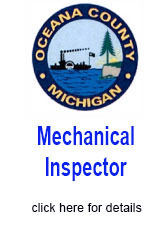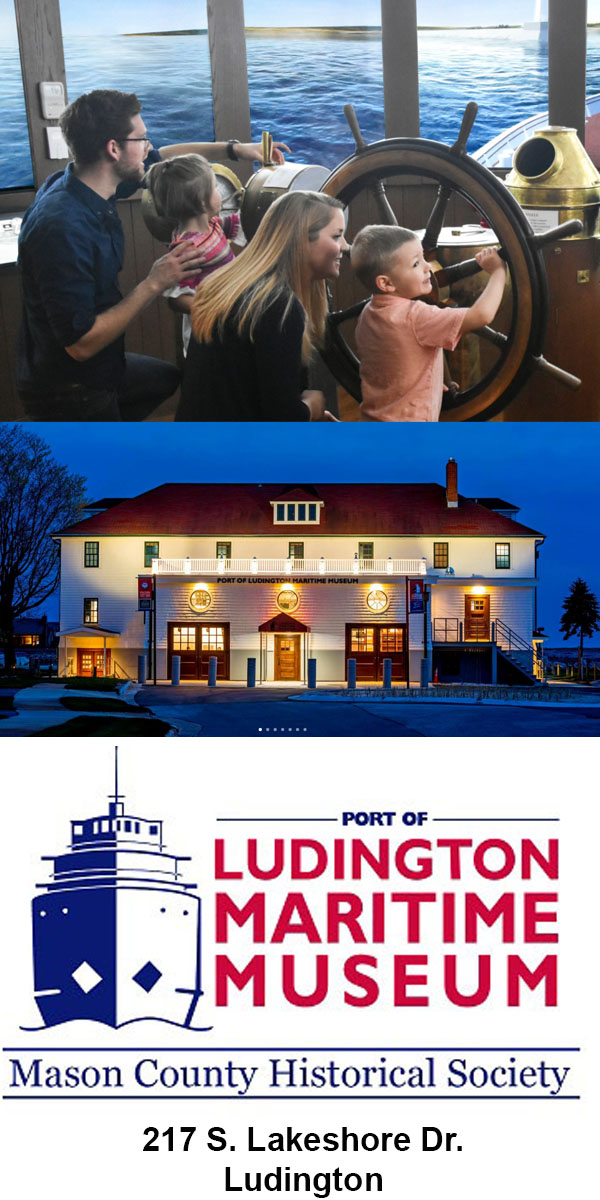
The City of Ludington
This MCP Maritime History Blog is presented by Filer Credit Union and Mason County Historical Society’s Port of Ludington Maritime Museum.
By Rob Alway, Editor-in-Chief

Capt. Albert Goodrich
The Goodrich Transportation Co., later known as the Goodrich Transit Co., operated for over 80 years and, at one time, was the largest passenger and freight service on the Great Lakes, operating mainly on Lake Michigan. The company was founded by Capt. Albert Goodrich in 1855, when he was 30-years-old, when he took possession of his first side-wheel steamship, the 165-foot-long Huron, built in 1852.
Goodrich’s corporate offices were located in Chicago but its ships were based out of Manitowoc, Wis.
The company’s relationship with Ludington began in 1876, two years after the Flint & Pere Marquette Railway reached its terminus in the city that had been incorporated in 1873.
In 1875, the F&PM chartered the 175-foot-long side wheeler steamer John Sherman for break-bulk service to shuttle grain, packaged freight and passengers between Ludington and Sheboygan, Wisconsin to connect with the Sheboygan & Fond du Lac Railway. The Sherman only served one year as it was too small for the railroad’s needs.
Break-bulk steamers carried railway freight from shore to shore. Railcars at that time did not travel across the lake, so the contents of the cars were removed, loaded onto the break-bulk steamer, shipped across Lake Michigan, then re-loaded onto railcars waiting on the other shore.
The next year, Goodrich Transit Company was awarded a lucrative contract by the F&PM and began shipping from Ludington mainly to Milwaukee.
In 1880, the Goodrich Transportation Co. awarded a contract to Rand & Burger Co., shipbuilders in Manitowoc, Wis., to build the company a wooden freight and passenger ship. In the spring of 1881 the ship was delivered and christened the City of Ludington, in honor of the City of Ludington. It would be the last wooden ship built for the Goodrich fleet.

Edward Allis
The City of Ludington was 180 feet long, 35 feet, 6 inches wide and had a draft of 12 feet. It was designed for cross-lake year-round service, which included a reenforced bow and a sturdy still hull. The ship’s promenade deck included 44 passenger staterooms. The public rooms were spacious and given elegant decoration. The arched trusses, to add longitudinal strength to the hull, and typical of the ships of that era, appeared on its hurricane deck.
A unique feature of the City of Ludington was its engine. Capt. Albert E. Goodrich, owner of the Goodrich Transportation Co., had an interest in experimenting with new propulsion systems. The new ship’s engine was a Reynolds-Corliss high pressure marine engine. It had a 24-inch bore and a 36-inch stroke and was produced by the plant owned by Edward P. Allis in Milwaukee. Later, the plant would become the Allis Chalmers Co. and become a major manufacturer of tractors and other agricultural equipment.
Interestingly, it was the only marine engine that Allis would every produce even though the ship’s engine had a very successful career.
The City of Ludington’s first winter proved its sturdiness. The winter of 1881-1882 was severe. The ship spent over a month stuck in the ice traveling up and down the eastern Lake Michigan shoreline. While on an eastbound crossing, the City of Ludington became entrapped in a huge ice floe as it approached the Michigan shore. Unable to work free it had no choice but to move up and down Lake Michigan in the relentless grip of the huge floe. After a week the steamer found itself at the southern end of the lake just off St. Joseph one morning and a few days later it was near Manistee. In that length of time it had traveled over 150 miles without its shaft turning a single revolution.
At one point during the month of its entrapment crew members went to shore to make contact with Goodrich officials and pick up badly needed supplies. Finally a warming spell and a sudden shift in wind caused the floe to break up and release the ship.
Surprisingly, an examination revealed no hull damage. The ship was then returned to its regular run.

F&PM No. 4
In 1883, the F&PM terminated its contracts with Goodrich, a controversial move, in favor of operating its own steamers, which would eventually become known in Ludington as the “black boats.” The first two vessels were the Flint & Pere Marquette (F&PM) No. 1 and No. 2. Eventually, three more F&PM boats were built. In 1897, the end of the black boats was near as the F&PM debuted its first steel car ferry, the Pere Marquette. By 1903, after the formation of the Pere Marquette Railway, which included the absorption of the F&PM, the car ferries had completely replaced the black boats. However, those ships were then operated by the Pere Marquette Line Steamers, owned by Gus Kitzinger of Manistee.
While the City of Ludington was often spared major damage, it did experience its share of mishaps.
In 1885, the City of Ludington also found itself lodged in the ice a few miles north of its namesake, off of Big Sable Point. The ordeal didn’t last as long as the 1882 incident but did result in the crew members making their way to sure to report their whereabouts to the crew of the Big Sable Point Lifesaving Station.
That year, the City of Ludington also rendered aid to the Oneida, which was stuck in the ice off the shore of Grand Haven. Food, supplies and some fuel were given to the Oneida crew who spent 23 days in the ice before that ship was able to get free.
The City of Ludington ran aground just off of Manistee in January 1886. With the aid of the Lifesaving Service from Manistee, the ship was freed without hull damage and it continued across Lake Michigan with its cargo of barreled salt.
In November 1889, a heavy fog caused the ship to go aground at Peninsular Point near Escanaba. A tug was able to pull it free without severe damage.
On Thanksgiving Day of that same year, the City of Ludington had a mishap near Horseshoe Island in Green Bay near Wisconsin. The ship had been seeking shelter behind the island and had parted its lines in a storm of gale force. It then drifted past Eagle Harbor and ended up on a large flat rock in Shanty Bay on the west shore of Eagle Harbor. After the storm, the Goodrich steamer De Pere went to the Ludington’s assistance. De Pere removed the cargo in an attempt to lighten its draft. Then three tugs attempted to assist, to no avail.
Since the ship was in a sheltered spot, Capt. Butlin decided to let it remain where it was until spring when conditions would be more favorable for its removal. A shanty was built on the beach and one man kept vigil on the ship all winter.

Goodrich Transit Yards, Manitowoc
Efforts to free the ship renewed in the spring of 1890, utilizing heavy hydraulic jacks and the services of the tugs Arctic and Monarch. The steamer was finally inched into deep water and then towed it to Manitowoc where it arrive on May 15, 1890.
It was immediately place in dry dock where inspection revealed that it had sustained severe hull damage. Capt. Goodrich, owner of the fleet, decided to not only repair the hull damage but also authorized another $10,000 for general improvements.
When work was completed it was returned to regular Goodrich routes during the summer of 1890.
The City of Ludington was one of the first steamers on the Great Lakes to be lighted by electricity. It was also the first Goodrich steamer equipped with an electric searchlight.

Capt. Edward G. Stines
A tragedy that indirectly impacted the City of Ludington occurred on Jan. 21, 1895 when the Graham & Morton Line’s Chicora went missing. The ship was commanded by Capt. Edward George Stines (1848-1895), brother of Capt. Henry E. Stines (1845-1919), skipper of the City of Ludington. The Ludington spent two days seeking the lost steamer. Chicora was lost in a freak storm and no trace of those aboard were ever found.
The Stine brothers were both born in Saratoga, NY, to Richard Stine (1815-1853) and Jane (Duffy) Stine (1817-1908).
Capt. Edward Stine was born in Saratoga, NY and was married to Sarah Williams (1852-1911) on April 10, 1870 in St. Joseph, Mich., where they resided. They had two children, Benjamin Edward, born in 1871, and Bernice (1872-1879). Sadly, Benjamin also died on the Chicora. Sarah remarried in 1901 to John Henry Meeker (1837-1915) in Porter, Indiana.
Capt. Edward Stines’s son, Benjamin Edward Stines, born in 1871, was also lost in the shipwreck.
Capt. Henry Edward Stines was married to Henrietta Riley Murphy Stines (1846-1926) on Nov. 7, 1867 in St. Joseph, Mich. They had two children, George Henry (1859-1928) and Charles Richard (1871-1948). Prior to Henry’s death, the couple was living in Chicago.
In the spring of 1898, the City of Ludington returned to the Burger & Burger ship yard in Manitowoc where it was cut in two and lengthened 30 feet. This increased its tonnage rating to 950 gross tons. After 18 years of service, the Corliss engine was removed and replaced with a larger power plant that had been built at the Dry Dock Engineering Co. in Detroit. During the 1898 rebuild, the public rooms and staterooms were completely renovated and improved.

Sinking of the City of Ludington in 1920
When the work was completed the ship was renamed Georgia, likely a snub to the F&PM RR. It was assigned the the Chicago to Mackinac Island route, departing every Monday afternoon at 2 p.m., making its first stop in Milwaukee and then other ports on Lake Michigan’s west shore. When it departed Mackinac Island it would depart for White Lake in Muskegon County, Mich., departing there on Sunday night with an arrival in Chicago early Monday morning.
A mishap in the fog on June 6, 1903 resulted in the firing of Capt. Edward Carus. The ship had been groping its way in zero visibility fog and shortly after midnight fetched up on Dunlop Reef on the south end of Green Bay just north of Sturgeon Bay.

SS Georgia
Unable to free itself, the ship remained there until daylight at which time aid came from two tugs. Superintendent W.H. Cochrane supervised the re-floating of the stranded steamer. When Georgia was finally pulled free it was sent to Manitowoc for inspection. It had sustained some hull damage and was then laid up for repairs. The company determined it was the captain’s fault and dismissed him of his duties.
Edward Carus was born April 15, 1860 in Manitowoc, the son of Frederick Carus (1819-1896) and Ernstine Carus (1840-1864).
He had a lengthy sailing career, which began aboard Great Lakes schooners in 1874. During his tenure with Goodrich, he commanded the City of Ludington/Georgia and Sheboygan.
Carus was also an avid maritime historian who had kept thousands of photographs and other documents about Great Lakes shipping. In the 1930s, he was in financial distress and sold his collection to Henry Barkhausen, who eventually donated it to the Wisconsin Maritime Museum.
Carus passed away following a stroke in August 1947 while sitting outside his home at 1209 Franklin St. in Manitowoc.
In 1914, the Georgia underwent another extensive overhaul. This time it received new Scotch boilers but retained its engine that had been installed in 1898. All decayed or faulty hull planking was replaced and the ship was given a general refurbishing. After the overhaul, Georgia was no longer used in winter service and as a result was laid up each winter at Manitowoc. During its lay-up in the winter of 1919-1920 it had its last and most unique misfortune.

Gus Kitzinger
Georgia was moored in the Manitowoc River at the Goodrich dock under the bluff in the upper harbor. Its starboard side was to the dock and it was made secure with the usual extra lines and a wire cable. During the night of Feb. 19, 1920, the ice in the river began to move and pulled the caulking from its hull planking. As a result water poured into the steamer and it filled and sank. The next morning Georgia rested on the river bottom with a sharp list to its port side.
The ship was pumped out, raised and taken to dry dock for new hull caulking. After a thorough interior cleaning it was ready again to resume its role as a Goodrich summer boat.
During the summer of 1920, Goodrich sold the ship to the Crosby Line for $75,000. Its new owners placed it on cross-lake service out of Muskegon until 1925 when it sold to Pere Marquette Line Steamers and operated between Manistee, Ludington and Milwaukee, thus ending its career operating to the city it was originally named after.
In 1927, Georgia was declared obsolete and laid up at Manistee. Capt. John Roen purchased Georgia and towed it to Sturgeon Bay for dismantling.
After removal of its machinery and most of its topsides and interior, the bare hull was sold to a group that was developing a new stone quarry on Summer Island, located just north of Washington Island, Door County, Wis. On arrival at Summer Island, Georgia was filled with stone and sunk to help form a loading dock for the new quarry, ending the illustrious career of the 47-year-old ship.

Goodrich Muskegon docks, now known as the Mart Dock.
This article brought to you by….
Filer Credit Union features offices in Manistee, Ludington and Bear Lake, 800-595-6630, www.filercu.com

The Mason County Historical Society is a non-profit charitable organization that was founded in 1937 that does not receive any governmental funding. It owns and operates the Port of Ludington Maritime Museum in Ludington, Historic White Pine Village in Pere Marquette Township, and The Rose Hawley Archives and the Mason County Emporium and Sweet Shop in downtown Ludington.
The Port of Ludington Maritime Museum, located at 217 S. Lakeshore Dr., Ludington, is currently open Thursday through Saturday from 10 a.m. to 5 p.m. until Tuesday, May 27 when it will be open Tuesday from 11 a.m. to 7 p.m. and Wednesdays through Saturday from 10 a.m. to 5 p.m.
For more information about donating to and/or joining the Mason County Historical Society, visit masoncountymihistory.org.

SS Georgia

Sources for this article:
“Red Stacks Over the Horizon” by James L. Elliott, 1967
“Lake Michigan Passenger Steamers” by George Hilton, 2002
Mason County Historical Society Rose Hawley Archives and Port of Ludington Maritime Museum, Ludington, Mich.
Wisconsin Maritime Museum, Manitowoc, Wis.
Manistee Historical Museum
__________________________
Please Support Local News
Receive daily MCP and OCP news briefings along with email news alerts for $10 a month. Your contribution will help us to continue to provide you with free local news.
Payment can be made monthly via credit card, bank account, PayPal or Venmo through recurring email invoicing. These payments can be set up for autopay each month.
To sign up, email editor@mediagroup31.com. In the subject line write: Subscription. Please supply your name, email address, mailing address, and phone number (indicate cell phone). We will not share your information with any outside sources. For more than one email address in a household, the cost is $15 per month per email address.
Alternative methods:
PayPal Monthly Payment. Click this link.
We can send you an invoice for a yearly payment of $120, which you can conveniently pay online or by check. If you are interested in this method, please email editor@mediagroup31.com and we can sign you up. You can also mail a yearly check for $120 to Media Group 31, PO Box 21, Scottville, MI 49454 (please include your email address).
Payment must be made in advance prior to subscription activation.
We appreciate all our readers regardless of whether they choose to continue to access our service for free or with a monthly financial support.
_____
This story and original photography are copyrighted © 2025, all rights reserved by Media Group 31, LLC, PO Box 21, Scottville, MI 49454. No portion of this story or images may be reproduced in any way, including print or broadcast, without expressed written consent.
As the services of Media Group 31, LLC are news services, the information posted within the sites are archivable for public record and historical posterity. For this reason it is the policy and practice of this company to not delete postings. It is the editor’s discretion to update or edit a story when/if new information becomes available. This may be done by editing the posted story or posting a new “follow-up” story. Media Group 31, LLC or any of its agents have the right to make any changes to this policy. Refer to Use Policy for more information.





















































.png)


